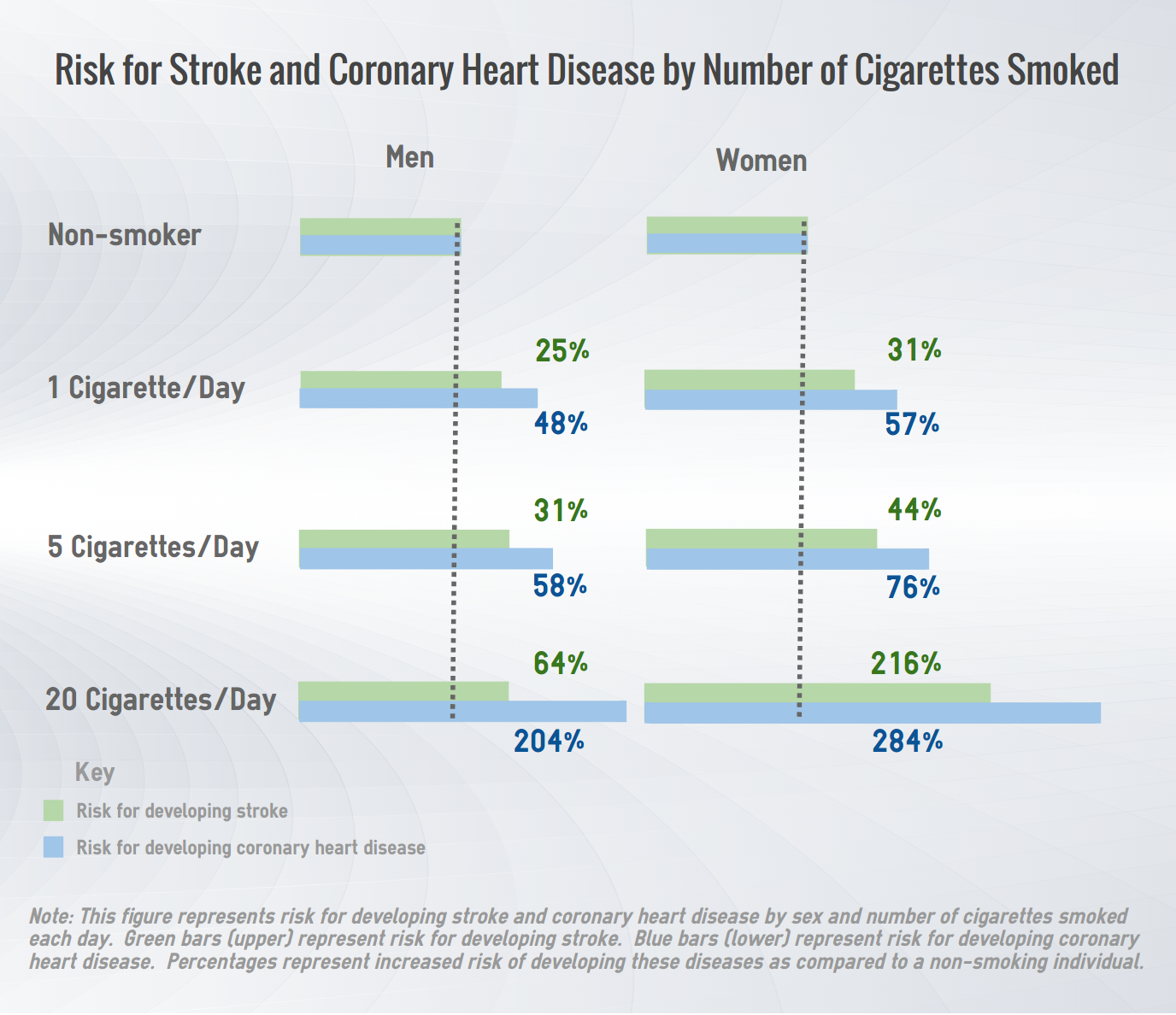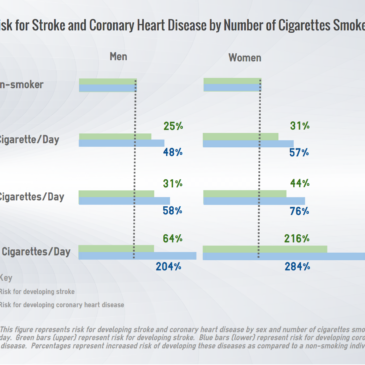Cigarette smoking is related to an increased risk for developing stroke, lung disease, and coronary heart disease. In order to reduce negative health impacts related to cigarette smoking, some interventions advise smokers to reduce the number of cigarettes smoked each day. This week, ASHES reviews a study by Allan Hackshaw and colleagues that explores whether smoking one cigarette each day relates to stroke and coronary heart disease.
What is the research question?
How does low cigarette consumption relate to coronary heart disease and stroke?
What did the researchers do?
The researchers performed a meta-analysis on 55 studies that included a combined total of approximately 5.6 million men and women. They included only studies that (1) reported on cigarette consumption and its relationship to coronary heart disease and stroke; (2) reported at least 50 cardiovascular disease events (i.e., participants who either died or became ill as a result of stroke or coronary heart disease during the course of the study); (3) reported hazard ratios for developing the disease; (4) used a population of generally healthy participants; and (5) either gave results separately for men and women or controlled for gender when these groups were combined. The researchers combined patterns of smoking to create four mutually-exclusive groups: never smoked, smoked 1 cigarette a day, smoked 5 cigarettes a day, and smoked 20 cigarettes a day. The researchers used a regression model to assess whether the number of cigarettes smoked each day related to later development of stroke and coronary heart disease.
What did they find?
Both men and women who smoked cigarettes were more likely than non-smokers to develop both stroke and coronary heart disease. Risk for developing both diseases increased with the number of cigarettes smoked each day. Smoking just one cigarette a day (compared to not smoking) was associated with largest increase in risk for developing these diseases relative to the number of cigarettes smoked per day. (See Figure 1). Female smokers were more likely than male smokers to develop these diseases, regardless of the number of cigarettes smoked.
 Figure. Risk for stroke and coronary heart disease by number of cigarettes smoked. Click image to enlarge.
Figure. Risk for stroke and coronary heart disease by number of cigarettes smoked. Click image to enlarge.
Why do these findings matter?
Although reducing smoking is an important starting point, smoking interventions designed only to reduce cigarette consumption–without encouraging quitting– might not be enough to reduce risk for smoking-related health impacts. Interventions should target quitting as the primary goal for smokers.
Every study has limitations. What were the limitations in this study?
Many of the publications analyzed in this study discussed cigarette consumption in terms of average rates (e.g., one to five) rather than the specific numbers used in this study (i.e., 1, 5, or 20). Individual smoking habits vary across time, so use of a single number might not be representative of actual risk for harm. This study only looked at the negative health impact of coronary heart disease and stroke. A follow-up study designed to include lung cancer as well as other negative health impacts might find different rates of risk for each disease.
For more information:
SmokeFree offers tools and tips quitting and maintaining abstinence from smoking. For additional tools, please visit the BASIS Addiction Resources page.
— Pat Williams
What do you think? Please use the comment link below to provide feedback on this article.





Erik Nord February 24, 2018
Oslo, February 24 2018
Fake evidence and scientific misconduct regarding health risks at 1 cigarette a day
Erik Nord, senior researcher at the Norwegian Institute of Public Health and professor in health economics at the University of Oslo.
The report by Hackshaw et al on disproportionately high risks of CVD associated with smoking one or a few cigarettes a day, published in the BMJ on January 24, addresses an important public health issue, but is false in content and represents scientific misconduct. The media that picked up Hackshaw et al’s results and forwarded them to the public should rectify their earlier message and look at the matter from a different, but no less interesting news angle: How is it possible that completely useless research can be accepted for publicaton in the British Medical Journal?
It is true that there is some earlier evidence that risk of cardiovascular disease increases considerably already at low levels of cigarette consumption. Hackshaw et al’s extensive literature review purports to bring further evidence, focussing particularly on risk at 1 cigarette a day, and Hackshaw et al clearly give the impression that they have very extensive observations of risk at this level of consumption. But the studies reviewed by Hackshaw et al have absolutely no data on one cigarette a day. They do not even come close. The subgroups of smokers with the lowest reported levels of consumption in 50 % of the studies have a mean consumption of around 7-8 cigarettes per day and in 40 % of the studies around 11-14 CPD.
Details are reported at http://www.bmj.com/content/360/bmj.j5855/rapid-responses . I here reiterate the essential table, as this unfortunately collapsed in the online publication in the BMJ.
Distribution of 27 studies in figures 1, 3 and 4 on ‘lowest consumption category used in the study’:
Lowest interval Number of studies Midpoint used by Hackshaw et al Evidence based mean
1-4 1 2.5 3
1-7 1 4 5-6
1-9 14 5 7.5-8
1-14 6 7.5 11-12
1-19 5 10 13-14
Sum 27
To avert any misunderstanding, I stress that the point here is not that low level smoking should be thought of as having a negligible risk. From a public health point of view, but also in view of the pleasure that many derive from modest smoking and the problems many have with quitting completely, it is an important research task to establish how high the risk of ‘one or two a day’ is. The point here is that no matter what the research theme is, and hence even when the theme is consumer behaviour of which the majority of people and health politicians disapprove (here: smoking), researchers must try to remain neutral researchers and respect the rigorous rules of empirical science and evidence based medicine. Otherwise policy makers will be led to make decisions on false premises, and over time the general public’s faith in science will be compromised.
In the present case, I do not doubt Hackshaw et al’s good intentions. But their misrepresentation of evidence is – de facto – misconduct. The severity of it is amazing. The only reasonable explanation seems to be that they are on a mission. Unfortunately they are not the first ones, cfr http://www.bmj.com/rapid-response/2011/10/30/passive-smoking-non-smoking-researchers%E2%80%99-personal-values-cause-conflict-in , and will surely not be the last ones.
I conclude that the media should reopen the case.
Pat Williams February 26, 2018
Hi Erik,
Thank you for reading this review and raising such important concerns. In the link you provided, Hackshaw et al. made a rebuttal on 12 February, 2018 addressing several of the points you raised. We provide them below:
“…One cigarette per day was always within the observed consumption ranges used in the studies, therefore a data point of say 5 per day actually represents an average of 5 per day and thus include down to 1 per day. As such, estimating relative risks (RR) for 1 per day does not represent extrapolation, but rather interpolation. Please note that there would not be a category of 0-10 or 0-5 per day because this will mix up smokers and never-smokers; the categories are always of the form 1-5 or 1-10. Furthermore, our estimates for 1 per day, using modelling based on categories of cigarette consumption, are close to that using the CPS II study.
…To clarify, we were not providing absolute risks of cardiovascular disease in any group. The official press release reported the excess (relative) risks. Some individual news items followed this, whilst others (in addition or instead) chose to extract information from the BMJ paper on the relative risk compared to never smokers. They are different measures, and this probably explains the understandable confusion.
…it is not correct that the RR for a category of say 1-10 per day is taken to be the same as for 1 per day. A published estimate for 1-10 per day is used in a regression, producing a model which can then be used to estimate RR for 1 per day…”
All the best,
Pat Williams
Sheli January 13, 2020
I’m trying to discover any data on e-cigarettes as a harmless or unsafe substitute for cigarettes. While nicotine can be condensed, are there other chemicals in e-cigarettes that are injurious?
Heather Gray January 14, 2020
Thanks for your question, Sheli. The short answer is yes, there are other chemicals in e-cigarettes that can be harmful. The US Surgeon General’s website (https://e-cigarettes.surgeongeneral.gov/) says the following:
“Besides nicotine, e-cigarettes can contain harmful and potentially harmful ingredients, including ultrafine particles that can be inhaled deep into the lungs; flavorants such as diacetyl, a chemical linked to serious lung disease; volatile organic compounds; heavy metals, such as nickel, tin, and lead.”